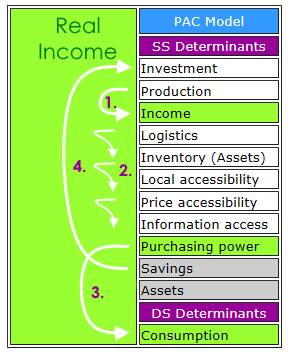Hector McNeill
1
SEEL
Further advances in RIO-Real Incomes Objective concepts have now added specific structural details to explain why the Say Model of the economy has been undermined. Many of today's economic ills including inability to address income disparity, sustainability and climate change can be linked to the encapsulation of classes of economic activity driven by financialization rather than an objective to maintain equilibrium in the distribution of real incomes.
|
Encapsulation:
Encapsulation separates and summarizes the most important determinant relations governing a sub-set of properties; not fully integrated with the main model. |
|
|
Background
Jean Baptiste Say
1767–1832 |
The basic Say mode of the economy is a useful reference standard for evaluating the relationship between real income distribution and the equilibrium between production and consumption.
The Say Model remains a demonstration of a supply side model. It encapsulates the relationship between production, wages and consumption where consumption represents the real incomes achievable with the total disposable income (wages). Because in its simplest form this is an enclosed economy all within the supply side it is a useful core with which to explore different macroeconomic structures.
The Production, Accessibility & Consumption Model is based on the Say Model and is shown on the right. In essence as long as wages are sufficient to gain access to the output of goods and service companies the consumption and flow of funds back to production companies comes from wages paid by the production companies. Similarly, those employed in capital goods and services companies servicing the production sector spend their wages on the output of goods and service companies. As a result capital goods and service employment augments the disposable incomes that give rise to consumption of goods and service companies.
Endofin - Endogenous fundsThe fact that the majority of the cashflow of companies producing goods and services are essentially an internal supply side cashflow they are referred to, in RIO-Real Incomes Objective analysis, as "endogenous funds". The basic charactsristics of such an economy is equilibrium and stability.
 Exofin - Exogenous funds
Exofin - Exogenous fundsOne of the effects of monetary policy is to introduce increased money volumes based on debt. This has been intensified by quantitative easing (QE) where large monetary volumes are associated with very low interest rates. These funds, rather than flow into the endogenous fund cash flow within the supply side goods and services production activities and thereby into wages on into supply side investment, tend to flow into capsules or self-contained activities associated with investments in offshore activities and assets. The capsules become isolated because there is no feedback mechanism through national wage packets, resulting in a depression in real income or purchasing power and consumption.
Inflation and depletion of wages and declines in employment and real incomesThere is a well-established, but yet to be established in practice, monetary policy assertion that rises in money volumes contribute to inflation. This assumes an encapsulation of money supply and the cash flow in the supply side of the goods and services economy. This does not exist in practice. This is because Exofin flows out of the supply side into the two separate and isolated capsules of:
- offshore investment
- onshore as well as offshore assets
These capsules are largely separated from the supply side economy as non-circulating funds.
Exofin - Exogenous funds creating offshore and asset capsules
 |